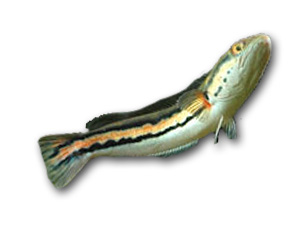Red Snakehead

Quick Stats
| Size | About 3 foot (90cm) |
|---|---|
| Tank | 400 litres + |
| Swimming Area | Middle |
| Ph | Not critical |
| Temperature | 80ºF + (28°C) |
| Food | Live fish |
Common Name:
Red Snakehead
Distribution:
Most from S.E. Asia . Africans less common.
Colouration:
Young snakeheads, and especially the juveniles of the red snakehead (C. Micropeltes), are very beautiful coloured with a bright red stripe along the side of the body. When the red snakehead get older the red will fade and make place for a dull coloured pattern.
Lifespan:
10 years +
Maintenance:
25% weekly water changes. Just like other labyrinth fishes, snakeheads have a labyrinth organ. This makes snakeheads capable of breeding atmospheric air. The gills alone aren't capable of filtering enough oxygen out of the water for the snakehead to live, so without this labyrinth organ the snakehead can't live. Therefore you should always leave some space between the water surface and the lid of your aquarium, so the snakehead can breath atmospheric air. Otherwise the snakehead will drown.
Feeding:
Snakeheads prefer live fish. They convert to non-live fish if you drop them near them when they're hungry. They will also eat worms. Snakeheads run up and try to eat any new fish you drop in their tank. They grab it to see if it fits in their mouth. If it doesn't fit, they let it go and usually don't try to swallow it again. Unfortunately, some specimens like to kill smaller fishes just for the fun of it. The most important is to give your snakehead(s) a varied diet, consisting of fish, worms, shrimp, grasshoppers and chicken fillet.
Substrate:
The bottom covered with gravel with some big plants if you like. Snakeheads don't really care about tank set up.
Tank Decor:
Robust large plants. Its really up to the owner what they want to decorate their tank with. The Snakehead doesn't care.
Filtration:
Provide good filtration and do frequent water changes. This fish can produce a lot of waste.
Biotype:
Found in still and sluggish waters of the tropical region of Africa and South-East Asia.
Breeding:
Only possible in a muddy pond.